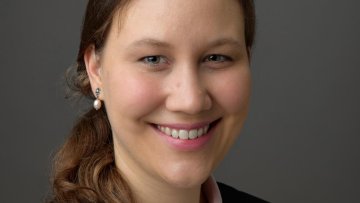The Anile-ECMI Prize is given to a young researcher for an excellent PhD thesis in industrial mathematics successfully submitted at a European university. It was established in honour of Professor Angelo Marcello Anile (1948-2007) of Catania, Italy and consists of a monetary prize of 2500 Euros and an invitation to give a talk at the ECMI 2021 conference on Wedneday 14 April.
I is a Strange Loop - Written and performed by Marcus du Sautoy and Victoria Gould
Tuesday 25 May 2021
5.00-7.15pm
From the creative ensemble behind Complicité’s sensational A Disappearing Number, this two-hander unfolds to reveal an intriguing take on mortality, consciousness and artificial life. Alone in a cube that glows in the darkness, X is content with its infinite universe and abstract thought. But then Y appears, insisting they interact, exposing X to Y's sensory and physical existence. Each begins to hanker after what the other has until a remarkable thing happens … involving a strange loop.
After the screening and to coincide with publication of the script by Faber, Marcus and Victoria are joined by Simon McBurney, founder of Complicite, to discuss the play and mathematics and theatre.
A discount of 25 per cent on the playtext is available from faber.co.uk using the code LOOP25 from May 20.
Watch (no need to register and it will remain available after broadcast):
The Oxford Mathematics Public Lectures are generously supported by XTX Markets.
14:15
Hilbert schemes for fourfolds and Quot-schemes for surfaces
Abstract
Counting coherent sheaves on Calabi--Yau fourfolds is a subject in its infancy. An evidence of this is given by how little is known about perhaps the simplest case - counting ideal sheaves of length $n$. On the other hand, the parallel story for surfaces while with many open questions has seen many new results, especially in the direction of understanding virtual integrals over Quot-schemes. Motivated by the conjectures of Cao--Kool and Nekrasov, we study virtual integrals over Hilbert schemes of points of top Chern classes $c_n(L^{[n]})$ and their K-theoretic refinements. Unlike lower-dimensional sheaf-counting theories, one also needs to pay attention to orientations. In this, we rely on the conjectural wall-crossing framework of Joyce. The same methods can be used for Quot-schemes of surfaces and we obtain a generalization of the work of Arbesfeld--Johnson--Lim--Oprea--Pandharipande for a trivial curve class. As a result, there is a correspondence between invariants for surfaces and fourfolds in terms of a universal transformation.
Human-machine interaction models and robo-advising
Abstract
In my talk, I will introduce a family of human-machine interaction (HMI) models in optimal portfolio construction (robo-advising). Modeling difficulties stem from the limited ability to quantify the human’s risk preferences and describe their evolution, but also from the fact that the stochastic environment, in which the machine optimizes, adapts to real-time incoming information that is exogenous to the human. Furthermore, the human’s risk preferences and the machine’s states may evolve at different scales. This interaction creates an adaptive cooperative game with both asymmetric and incomplete information exchange between the two parties.
As a result, challenging questions arise on, among others, how frequently the two parties should communicate, what information can the machine accurately detect, infer and predict, how the human reacts to exogenous events, how to improve the inter-linked reliability between the human and the machine, and others. Such HMI models give rise to new, non-standard optimization problems that combine adaptive stochastic control, stochastic differential games, optimal stopping, multi-scales and learning.
High-dimensional, multiscale online changepoint detection
Abstract
We introduce a new method for high-dimensional, online changepoint detection in settings where a $p$-variate Gaussian data stream may undergo a change in mean. The procedure works by performing likelihood ratio tests against simple alternatives of different scales in each coordinate, and then aggregating test statistics across scales and coordinates. The algorithm is online in the sense that both its storage requirements and worst-case computational complexity per new observation are independent of the number of previous observations. We prove that the patience, or average run length under the null, of our procedure is at least at the desired nominal level, and provide guarantees on its response delay under the alternative that depend on the sparsity of the vector of mean change. Simulations confirm the practical effectiveness of our proposal, which is implemented in the R package 'ocd', and we also demonstrate its utility on a seismology data set.



